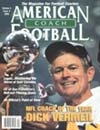AMERICAN FOOTBALL MONTHLY THE #1 RESOURCE FOR FOOTBALL COACHES
Article CategoriesAFM Magazine
|
Stripes—Life as a ZebraThe Umpire Position: Part One in a Seriesby: Bob Holliday Umpire, Big 12 Conference © More from this issue As coaches, I'm sure all of you know that Division One and NFL games are officiated by seven-man crews, consisting of the referee, umpire, head linesman, line judge, field judge, side judge and the back judge. But are you completely aware of the mechanics of each position? And do you know about the changes that have taken place within the past few years at each position? Furthermore, how familiar are you with the preparation each official puts forth, both individually and as a crew, before the season and prior to each game? The purpose of this series of articles - all written by Division I-A officials - is to educate and acquaint the reader more thoroughly about the mechanics, changes and issues associated with officiating each position on the field. All of the articles will be authored by Big 12 Conference officials, thus it i....The full article can only be seen by subscribers.
|
|
|||||||
| HOME |
MAGAZINE |
SUBSCRIBE | ONLINE COLUMNISTS | COACHING VIDEOS |
Copyright 2025, AmericanFootballMonthly.com
All Rights Reserved





